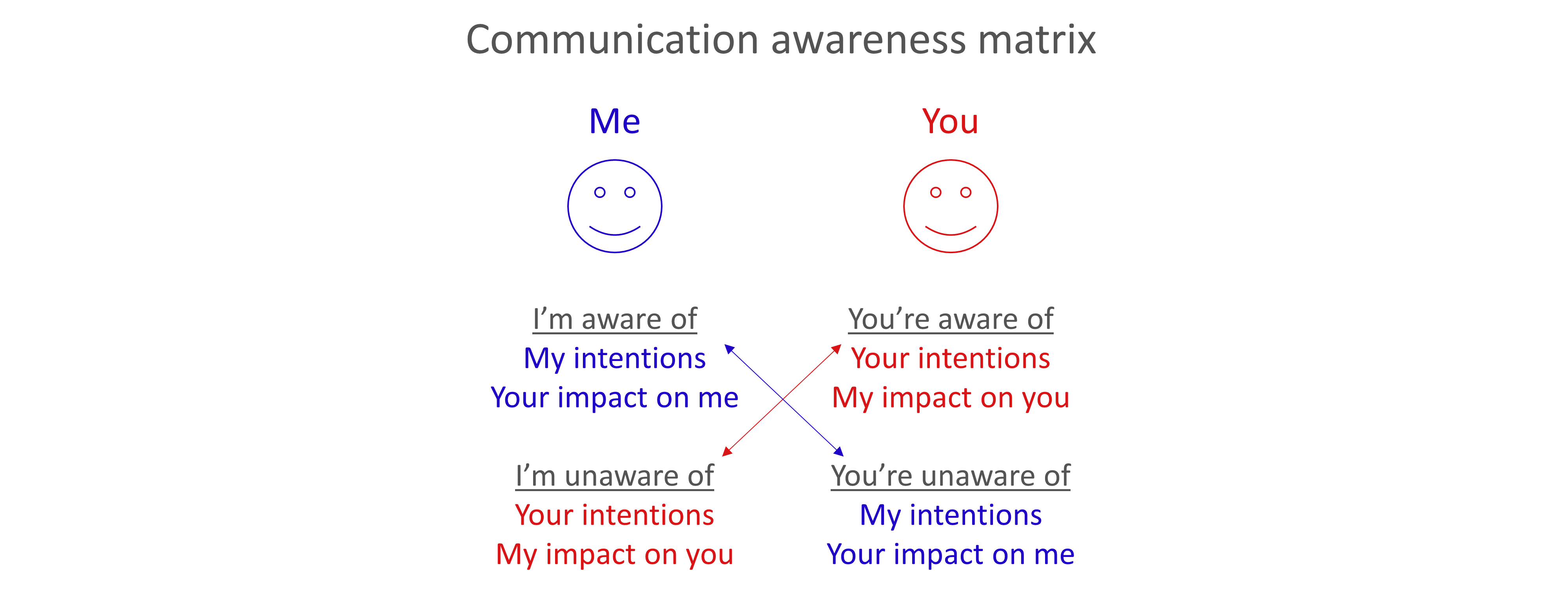Managing challenging behaviour
-
 Overview
Overview -
 Exercises
Exercises
Overview
In practice: Addressing issues of challenging behaviour quickly with the intention of helping the person reflect on their behaviour and recognise its impact. Seeking to create a safe space, free from blame, where you and the other person can have a constructive and kind conversation.
This isn’t an easy topic for most people, and with good reason. But it is normally better to act early to stop unhelpful behaviour before it gets out of hand.
When people work together, they share a common set of rights and expectations. These include, for example, to be treated with respect, not talked over, not humiliated, not belittled, not passed over on the basis of protected characteristics (race, sex, disability, etc).
Unacceptable behaviour at work is not straightforward. The behaviour can be intentional (or not), obvious to others (or not), and range from apparently innocuous comments to criminal acts. The behaviour can be directed outwards at others, or turned inwards in terms of attitude. It can be as subtle as just causing a bad feeling in the room.
From a leader’s perspective, it can also make you feel helpless and as a challenge to your position. No amount of planning (and no degree of natural authority, skill or confidence) makes you immune from coming across it. What we can do, however, is deal with it in the most appropriate way.
The obviously serious stuff
Although often extremely challenging, the more serious the behaviour is, the more straightforward the avenue to deal with it. If the behaviour clearly inappropriate or wrong, it’s certain to need to be referred directly to your HR or People colleagues. Protection from these actions is enshrined both in law and in your (and your colleagues’) employment contracts. The route here is simple – refer and take advice.
Everything else
The problem is with everything else. It’s difficult because behaviours can be difficult to pin down, and often have been going on for a significant period of time without the person being called on it - especially if the person exhibiting the behaviour is senior. The behaviour may be unacceptable but, if it has been left unchecked, may have developed into a ‘new normal’; it’s not ok, but it’s what people have come to expect.
What to do as a team leader? 3 approaches
Challenging behaviour isn’t unlocked with a single key. Here are three approaches you can try, depending on the kind of situation you encounter.
Remember – with all of the approaches, be kind and be courageous. Behaviour often gets worse because people don’t want to deal with it. As a rule, if you leave it alone, it will get worse – so tackle it as soon as you can.
- When you think a team member might be unaware of their unacceptable behaviour, or of its impact on other members of the team or on people outside the team, try the ‘Helping colleagues to reflect on their behaviour’ approach below. This approach is an attempt on your part to help a colleague become more aware of behaviour that is not being received well by others.
- Where you have tried the ‘Helping colleagues to reflect on their behaviour’ approach and it hasn’t worked, or you think a firmer approach is needed try the ‘Establishing boundaries and expectations’ approach below. Perhaps you feel that the behaviour has to stop but you want to try to resolve the issue locally before involving more formal processes within your organisation.
- If the situation has already developed into a conflict between two team members, or between you and a colleague, see the Resolving Conflict section.
1. Helping colleagues to reflect on their behaviour
For example: For where you think your colleague has little or no awareness of the behaviour.
The Harvard Negotiation Project1 suggests that at times of heightened emotion we can easily misunderstand each other’s words and actions. We interpret a brief email as rude, whereas it was hurried because the person wanted to let us know something quickly. The intention was to be helpful but the impact on us was to make us feel offended. We are aware of our own intentions and the impact others have on us but may not be so aware of others’ intentions or the impact we are having on them. However, we act at times like there is no distinction between the two sides of the diagram below.

Your goal with this framework is to help a colleague, who has little awareness about the impact of their behaviour, to start to generate some insight.
The main focus here is to be kind but be clear. If your colleague isn’t aware of the impact of their behaviour, then this might be an upsetting conversation for them. If that’s the case, lead with empathy but be clear in what you’re saying; they haven’t picked up on their colleagues’ response, so don’t expect them to necessarily appreciate nuance now. Here's the process step-by-step.
- Raise the issue in a clear and candid way. Have this conversation in private, and strike a respectful, enquiring tone. Defences have a tendency to fly up – anger, upset, denial. To avoid this, move yourself from the position of ‘judge’ to the position of ‘helper’ in the eyes of your colleague. State that you are not looking to find someone to blame, or make any judgments, but that you’re looking to understand so you can help.
- Make the space psychologically safe by introducing the issue as a learning opportunity, not a punitive one. Say that everyone has blind spots (and use an example from your own life – it really helps). It might be helpful to explain that your focus is on helping to make the work environment as positive as possible for everyone. You can introduce the Harvard model if the circumstances feel right.
- Ask your colleague for their perspective. People won’t tend to listen if they’re intimidated, humiliated or feel like they’re not being heard. Your goal is to understand what’s going on for them. Listen, and try not to interrupt too much. This part of the approach is about understanding their perspective, and not giving your opinion.
- Ask your colleague for their insight into the perspectives of others. You can ask questions like: ‘Why do you think [x person] might be thinking [x thing?]. What do you think might be going on here? Why do you think this has landed in the way it has with [x people / person].
- Ask what they see needs to change, if anything, going forward. Insight is key here; your colleague needs to come up with this. If they’re instructed not to do something, the change will be inauthentic and/or short lived.
Remember:
- Focus on understanding the other person’s perspective: Explore, don’t just explain.
- Explicitly rule blame out of the conversation.
- Recognise that you can’t force change, you can only invite a different way of looking at things.
- You might tentatively pose ‘what if you did this ….?” questions that encourage the other person to consider alternatives you think may help. Even better if they come up with their own ideas to improve the situation.
- Approach the conversation in the tone of discussing possible solutions together.
2. Establishing boundaries and expectations
Where the behaviour is unacceptable and has to stop, but you want to try and resolve the issue locally before having to involve formal processes. Note – this guidance comes secondary to any processes or advice from your organisation.
In the majority of cases, you’ll want to try the ‘Helping colleagues to reflect’ approach first. If you have and it hasn’t worked, or the situation calls for a firmer immediate response, try the following. Here's the process step-by-step.
- Choose your setting and tone.You’ll want a calm, private and ideally neutral space for this conversation. Emotions may be high, so a constructive tone will be useful. Avoid accusations and blame – they won’t get you anywhere.
- Set out the issue as you see it. Don’t lead with ‘you did x’ or ‘your behaviour was y’; your colleague will entrench their position. Say you’re not there to blame, but to have a constructive conversation.
- Ask them for their reflections on the problems that you’ve identified. Be curious about their answers, and ask them whether they would change anything about their actions.
- Tell them what you consider to be unacceptable. Ask them if they disagree, and, if so, whether they’re willing to change their behaviour. If they are, move to Step 5. If they’re not, or don’t see a problem, it might be time for HR.
- Contract with your colleague. Write down the behaviours which will change, and what you’d both like to see going forward. Focus on positive, constructive behaviour (e.g. as a team we’ll talk well to each other) rather than punitive (e.g. I agree to not swear at my colleague in the office).
- Set a date for review. Check in (for example in 2 weeks) so you can review together how things have developed.
3. Resolving a conflict
If the situation has already developed into a conflict between two team members, or between you and a colleague, see the Resolving Conflict section.
1. Stone, D., Patton, B., Heen, S. (1999). Difficult conversations: how to discuss what matters most. New York: Penguin. ISBN: 0 14 02.8852X
